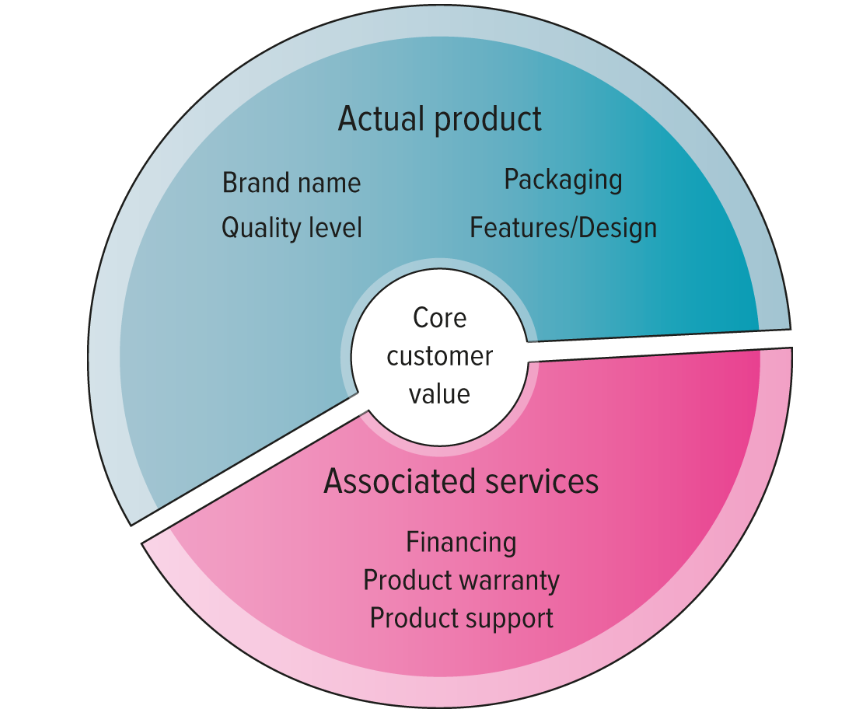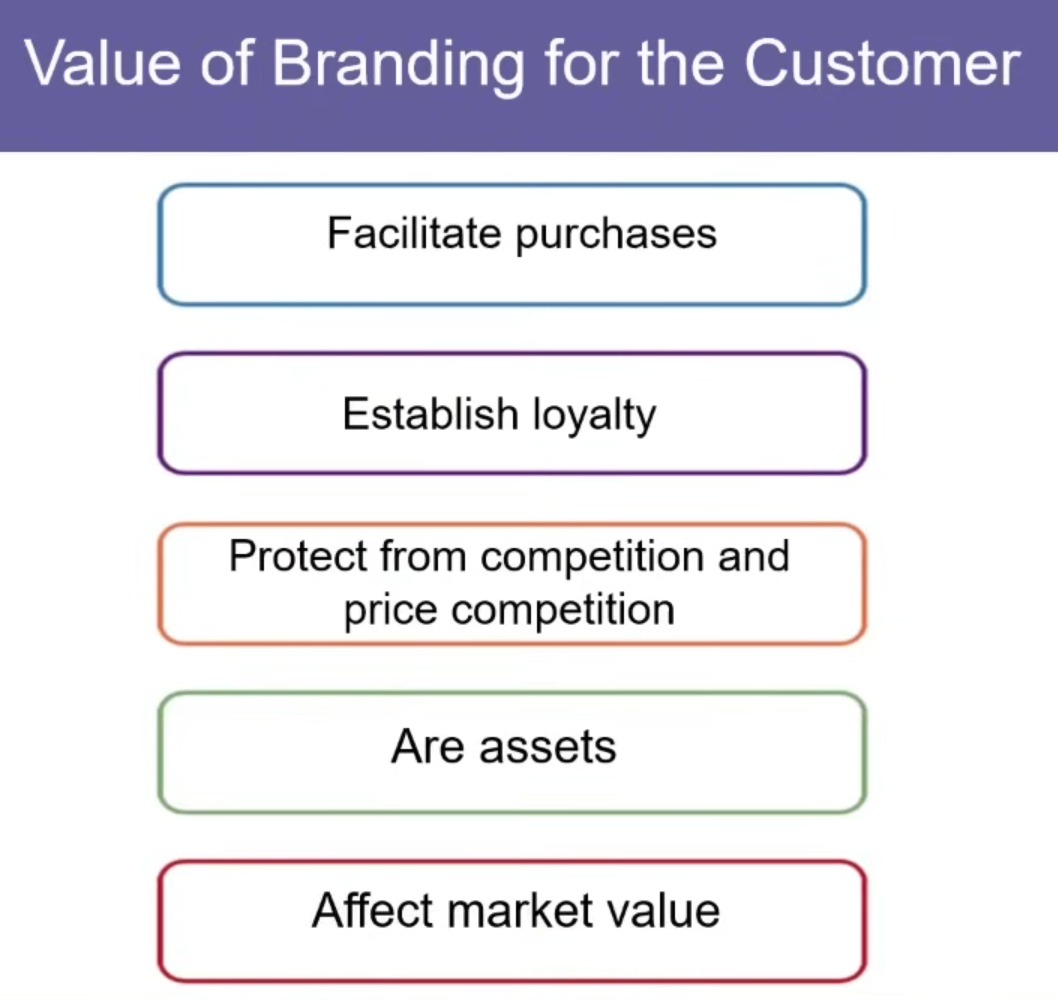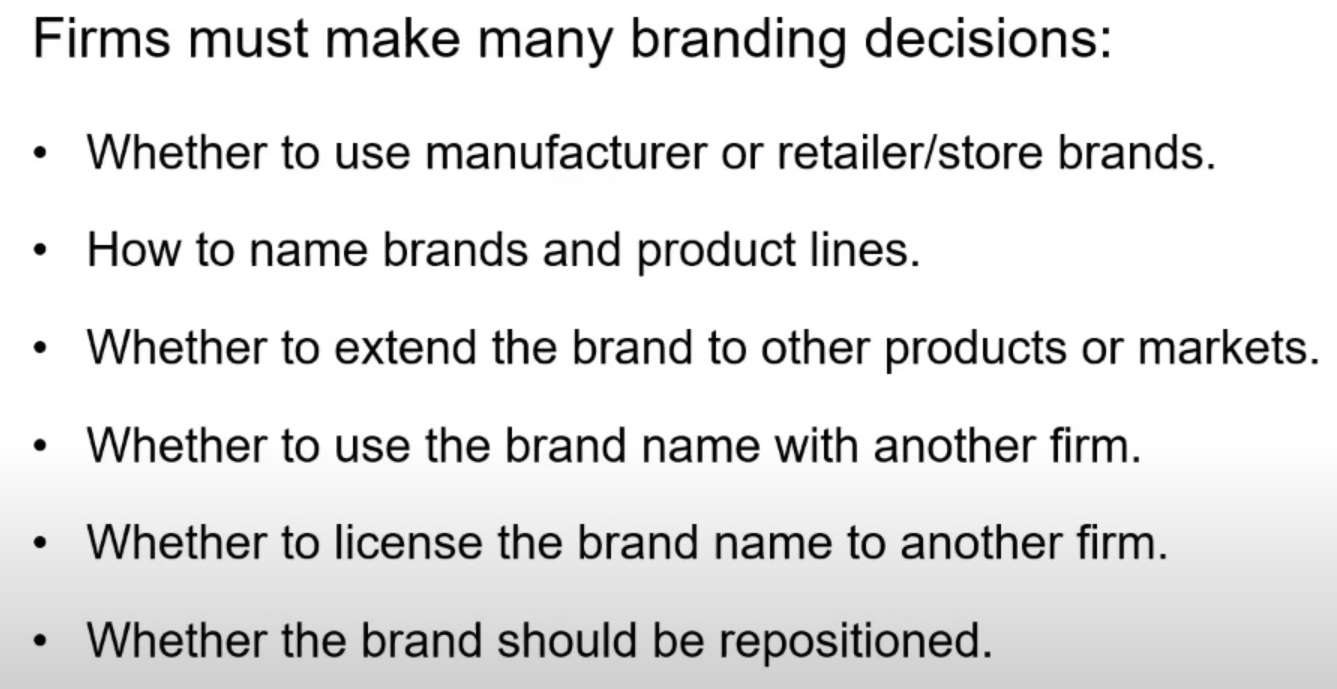Chapter 11: Product, Branding, and Packaging Decisions
1/55
There's no tags or description
Looks like no tags are added yet.
Name | Mastery | Learn | Test | Matching | Spaced |
|---|
No study sessions yet.
56 Terms
3 Components of a Product
Actual product: Brand Name, Quality Level, Packaging, Features/Design
Center: Core customer value
Associated services: Financing, Product Warranty, Product Support

core customer value
The basic problem-solving benefits that consumers are seeking.
actual product
The physical attributes of a product including the brand name, features/design, quality level, and packaging.
associated services (augmented product)
The nonphysical attributes of the product including product warranties, financing, product support, and after-sale service.
consumer products
Products and services used by people for their personal use.
4 Types of Consumer Products/Services
Specialty, Shopping, Convenience, Unsought
specialty products/services
Products or services toward which the customer shows a strong preference and for which he or she will expend considerable effort to search for the best suppliers.
shopping products/services
Products or services for which consumers will spend time comparing alternatives, such as apparel, fragrances, and appliances.
convenience products/services
Products or services for which the consumer is not willing to spend any effort to evaluate prior to purchase.
unsought products/services
Products or services consumers either do not normally think of buying or do not know about.
product mix
The complete set of all products and services offered by a firm
product lines
Group of associated items, such as those that consumers use together or think of as part of a group of similar products.
breadth (variety)
Number of product lines offered by a firm
depth
The number of products within a product line
cannibalize
When products are too similar and sales of one brand take away sales from the other brand with no increases in net sales, profit, or market share.
4 Changes to a Product Mix
Increase Depth
Decrease Depth
Decrease Breadth
Increase Breadth

6 Elements of Branding
Brand name
URLs
Logos and symbols
Slogans
Jingles/sounds

brand name element
Spoken component of branding
URLs element
Locations of pages on the internet substituting for the firm’s name
logos and symbols element
Visual branding elements that stand for corporate names or trademarks
characters element
Brand symbols that could be human, animal, or animated
slogans element
Short phrases used to describe the brand or persuade consumers about some of the brand’s characteristics
jingles/sounds element
Audio messages about the brand composed of words or distinctive music
Top 5 Global Brands (AMAGS)
Apple
Microsoft
Amazon
Google
Samsung

Ways that brands add value for customers and the firm
Facilitate purchases
Establish loyalty
Protect from competition and price competition
Are assets
Affect market value

Brands facilitate purchases
Brands are often easily recognized by consumers, signify a certain quality level with familiar attributes, and help them make quick decisions
Brands establish loyalty
Consumers learn to trust certain brands
Brands protect from competition and price competition
Strong brands are more established in the market and have a more loyal customer base, making competitive pressures less threatening
Brands are assets
Brands can be legally protected through trademarks and copyrights as a unique form of ownership
Brands affect market value
Having well-known brands can have a direct impact on the company’s bottom line
brand equity
The set of assets and liabilities linked to a brand that add to or subtract from the value provided by the product or service.
4 Components of Brand Equity
Brand awareness
Perceived value
Brand associations
Brand loyalty

brand awareness
Measures how many consumers in a market are familiar with the brand and what it stands for and have an opinion about it
perceived value
The relationship between a product or service’s benefits and its cost
brand associations
The mental links that consumers make between a brand and its key product attributes, such as a logo and its color, a slogan, or famous personality
brand loyalty
Occurs when a consumer buys the same brand’s product or service repeatedly over time rather than buying from multiple suppliers within the same category
Types of Branding Strategies
Brand Ownership
Naming Brands and Product Lines
Co-branding
Brand Licensing
Brand Repositioning

Brand Ownership
Manufacturer brands or Retailer brands

manufacturer/national brands
Brands owned and managed by the manufacturer
retailer/store brands
Private-label brands developed and marketed by a retailer and available only from the retailer
Naming brands and Product lines
Family/corporate brands or Individual brands
family brand
A firm’s own corporate name used to brand its product lines and products
individual brand
The use of individual brand names for each of a firm’s products
brand extension (increase breadth)
The use of the same brand name for new products being introduced to the same or new markets
line extension (increase depth)
The use of the same brand name within the same product line
Advantages to using the same brand name for new products
Brand name is already well established so the firm can spend less on developing brand awareness for the new product
If either the original brand or the brand extension has strong consumer acceptance, that perception will carry over to the other product
Brand extensions used for complementary products create synergy that can increase overall sales
brand dilution
Occurs when a brand extension adversely affects consumer perceptions about the attributes the core brand is believed to hold
What firms should consider to prevent negative consequences of brand extensions
Evaluate fit between product class of core brand and extension
Evaluate consumer perceptions of attributes of core brand, seek out extensions with similar attributes
Refrain from extending brand name to too many products
co-branding
The practice of marketing two or more brands together, on the same package or promotion.
brand licensing
A contractual arrangement between firms, whereby one firm allows another to use its brand name, logo, symbols, or characters in exchange for a negotiated fee.
brand repositioning (rebranding)
A strategy in which marketers change a brand’s focus to target new markets or realign the brand’s core emphasis with changing market preferences
primary package
The packaging the consumer uses, such as the toothpaste tube, from which he or she typically seeks convenience in terms of storage, use, and consumption
secondary package
The wrapper or exterior carton that contains the primary package and provides the UPC label used by retail scanners
sustainable packaging
Product packaging that has less of a negative impact on the environment
Key Roles of Packaging
Attracts consumers’ attention
Enables products to stand out from their competitors
Offers a promotional tool
Appeals to different markets